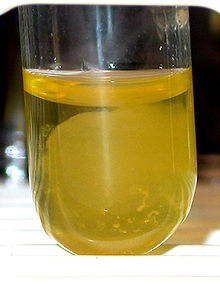- Coagulase
-
Coagulase is a protein produced by several microorganisms that enables the conversion of fibrinogen to fibrin. In the laboratory, it is used to distinguish between different types of Staphylococcus isolates. Coagulase negativity excludes S. aureus. That is to say, S. aureus is coagulase-positive.
It is also produced by Yersinia pestis.[1]
Coagulase reacts with prothrombin in the blood. The resulting complex is called staphylothrombin, which enables the enzyme protease to convert fibrinogen to fibrin. This results in clotting of the blood. Coagulase is tightly bound to the surface of the bacteria S. aureus and can coat its surface with fibrin upon contact with blood. It has been proposed that fibrin-coated staphylococci resist phagocytosis making the bacteria more virulent. Bound coagulase is part of the larger family of MSCRAMM
Contents
Coagulase test
The coagulase test is used to differentiate Staphylococcus aureus from coagulase-negative staphylococci. S.aureus produces two forms of coagulase (i.e., bound coagulase and free coagulase). Bound coagulase otherwise known as "Clumping factor" can be detected by carrying out a slide coagulase test and free coagulase can be detected by doing a tube coagulase test.
Slide test
Slide coagulase test is run with a negative control to rule out auto agglutination. Two drops of saline are put on to the slide microscopic slide labeled with sample number, Test (T) and control (C). The two saline drops are emulsified with the test organism by using wire loop, straight wire, or wooden stick. Place a drop of plasma (rabbit plasma anti-coagulated with EDTA is recommended[2] ) on the inoculated saline drop corresponding to test and mix well with wooden applicator stick. Rock the slide gently for about 10 seconds.
- If positive: Macroscopic clumping would be observed in the plasma within 10 seconds and no clumping in the saline drop.
- If negative: No clumping will be observed.
NOTE: If the slide coagulase test is negative, a tube test should follow as a confirmation. Clumping in both drops is an indication of auto-agglutination and therefore a tube test have to be carried out.
Tube test
The test uses rabbit plasma that has been inoculated with a staphylococcal colony (i.e., gram positive cocci which is catalase positive). The tube is then incubated at 37 degrees Celsius for 1½ hours. If negative then continue incubation up to 18 hours.
- If positive (i.e., the suspect colony is S. aureus), the serum will coagulate,[3] resulting in a clot (sometimes the clot is so pronounced that the liquid will completely solidify).
- If negative, the plasma remains liquid. The negative result may be S. epidermidis but only a more detailed identification test can confirm this, using biochemical tests as in Analytical Profile Index tests and BBL CRYSTAL methods.
- List of coagulase-positive staphylococci: Staphylococcus aureus subsp. anaerobius, Staphylococcus aureus subsp. aureus, Staphylococcus delphini, Staphylococcus hyicus, Staphylococcus intermedius, Staphylococcus lutrae, Staphylococcus schleiferi subsp. coagulans.
- List of coagulase-negative staphylococci of clinical significance: S.saprophyticus, S.cohnii subsp. cohnii, S.cohnii subsp. urealyticum, S.captitus subsp. captitus, S.warneri, S.hominis, S.epidermidis, S.caprae,S.lugdunensis.
References
External links
- Tube coagulase test - rabbit plasma video
- MeSH Coagulase
- Coagulase Test Procedure
Hydrolase: proteases (EC 3.4) 3.4.11-19: Exopeptidase Dipeptidyl peptidase (Cathepsin C, Dipeptidyl peptidase-4) · Tripeptidyl peptidase (Tripeptidyl peptidase I, Tripeptidyl peptidase II)Other/ungrouped3.4.21-24: Endopeptidase Serine proteases · Cysteine protease · Aspartic acid protease · Metalloendopeptidases
Other/ungrouped: Amyloid precursor protein secretase (Alpha secretase, Beta-secretase 1, Beta-secretase 2, Gamma secretase)3.4.99: Unknown Categories:- Microbiology
- EC 3.4.23
- Bacteria stubs
Wikimedia Foundation. 2010.


